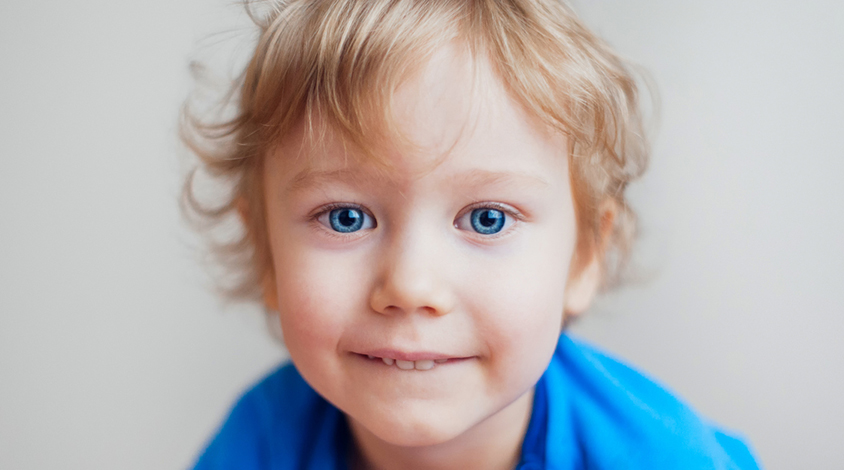
RYROLA / iStock
Genetics guides gaze during social interactions, study finds
The tendency of people with autism to not make eye contact is rooted in genetics, suggests a study of identical and fraternal twins.
The tendency of people with autism to not make eye contact is rooted in genetics, suggests a study of identical and fraternal twins, published today in Nature1.
The researchers did not look at twins with autism. They found that neurotypical identical twins spend similar proportions of time looking at people’s eyes when watching videos of social interactions.
The similarities are “absolutely striking,” says John Constantino, co-lead investigator and professor of psychiatry and pediatrics at Washington University in St. Louis. By contrast, fraternal twins show less similarity in their gaze patterns, and unrelated children show none at all.
This suggests that social gaze patterns are heritable — and may serve as an early marker of autism. However, to confirm that the atypical gaze in autism is also heritable, scientists would need to compare identical and fraternal twins with autism.
The researchers presented preliminary results from 83 typical twin pairs at the 2016 International Meeting for Autism Research in Baltimore. The new study adds data from 88 unrelated children with autism, and data from the initial group of children at a later age.
The children with autism spend much less time on average looking at other people’s eyes and mouths than do the typical children, the researchers found.
Reactions to the study are overwhelmingly positive — as they were at the conference last year.
“This is probably the most exciting paper I have read in the last several months,” says Helen Tager-Flusberg, professor of psychological and brain sciences at Boston University, who was not involved in the research. Gaze is a core component of social communication, so connecting this trait to genetics represents a significant advancement, she says.
Mirror movements:
Identical twins share the same DNA sequence, whereas fraternal twins, like non-twin siblings, share only half their DNA. Twin studies like this one look for a trait that is similar among identical twins, but differs among fraternal twins. “When that happens, you know that the drivers for that trait are genes,” says Constantino.
Constantino and his collaborators at Emory University in Atlanta, Georgia, looked at 41 identical and 42 fraternal same-sex twin pairs from the Missouri Family Register, as well as 84 age- and sex-matched controls from the Atlanta area. They also included 88 non-siblings with autism who had visited the Marcus Autism Center in Atlanta. All of the participants ranged in age from 18 to 24 months.
The researchers used eye-tracking technology to track the toddlers’ gaze as they watched a series of videos. Some videos show a woman speaking directly into the camera; others show children playing.
Using software, the researchers calculated how long each child spent looking at eyes, mouths, other body parts such as neck or hair, and background objects. They also tracked when and where each child’s gaze shifted.
They found that identical twins are much more likely than fraternal twins to move their eyes in the same direction at the same time. They also found that identical twins tend to spend a similar proportion of time looking at eyes, with a correlation score of 0.91 compared with 0.35 for fraternal twins; non-siblings scored close to 0.
The researchers tested the twins again 15 months later. The average correlation score for identical twins’ gaze ticked up slightly to 0.93. The average score for fraternal twins dropped to 0.25.
Facing forward:
Children with autism spend less time on average looking at eyes and mouths than do typical children, focusing instead on other body parts or inanimate objects.
The findings support a long-standing theory: that a person’s genetics can influence how he or she experiences the world2.
“That’s a concept we’ve had in the literature for a long time, but we haven’t had this kind of data,” says Joseph Piven, Thomas E. Castelloe Distinguished Professor of Psychiatry at the University of North Carolina at Chapel Hill, who was not involved in the work.
Some of the typical children in the study also spent little time focusing on eyes and mouths.
Some heterogeneity in the way children observe social scenes is to be expected, says Quentin Guillon, a postdoctoral researcher in Christina Schmitz’s lab at the Lyon Neuroscience Research Center in France, who was not involved in the research. Still, he says, the study should be replicated in a larger sample, and in twins with autism.
Constantino plans to look for genetic variants that guide social gaze in young children at risk of autism.
References:
Recommended reading

Too much or too little brain synchrony may underlie autism subtypes

Developmental delay patterns differ with diagnosis; and more

Split gene therapy delivers promise in mice modeling Dravet syndrome
Explore more from The Transmitter

Smell studies often use unnaturally high odor concentrations, analysis reveals

‘Natural Neuroscience: Toward a Systems Neuroscience of Natural Behaviors,’ an excerpt
